HP ProLiant DL160 Gen8 - feel it yourself
On Habré, there was already a review of the HP DL380 G8 in the HP company blog , however, the younger brother of this server, the DL160 G8, was somehow bypassed.
The other day there was a task to give the client a server with a large amount of RAM, but with a small number of disks. According to the client’s technical specification, the server must provide output to the Internet at a speed of 10-15 Gbit / s.
Usually we bought HP DL180 G6 servers of 2U size and 25 bytes for HDD / SSD for such tasks. But here the task was somewhat different, and we decided to try the new HP ProLiant DL160 8th generation.
')
Detailed information on this model can be found on the manufacturer's website, and I just want to share photos of fresh iron that can please connoisseurs.
Open the box, look ... what did you bring? Here is such a DL160 G8! The differences from the DL160 G5 are big. The DL160 line is increasingly stretching into the more expensive DL380 line. For example, there is already a place under the protective panel that restricts access to the HDD.

If you order a complete set without disks, then get ready that the server will arrive without one stub. Fans of diskless servers (for example, for a VMware cluster) will have to buy another server to parse the stubs. On the front side of the server there is also a monitor output, 2 USB ports, a power button and a LED button for many of your favorite UIDs.
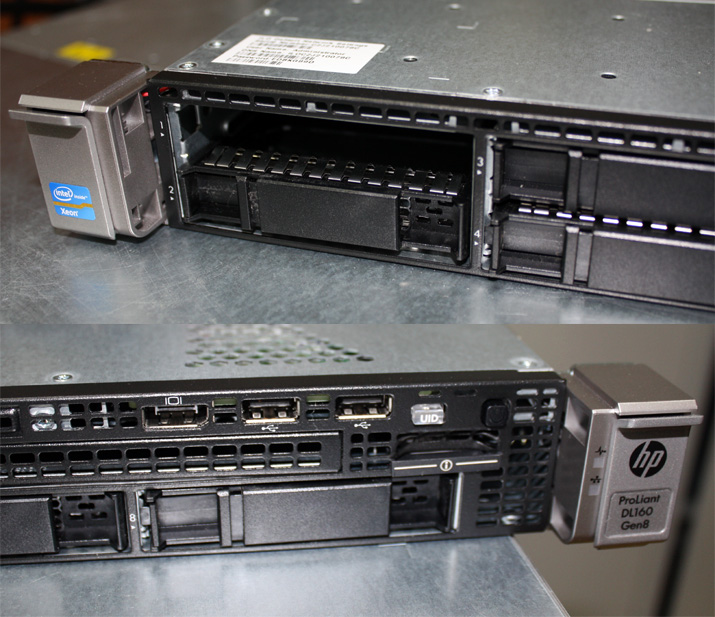
Special attention should be paid to the disks. Much has changed. Even the stubs of the empty compartments have changed.
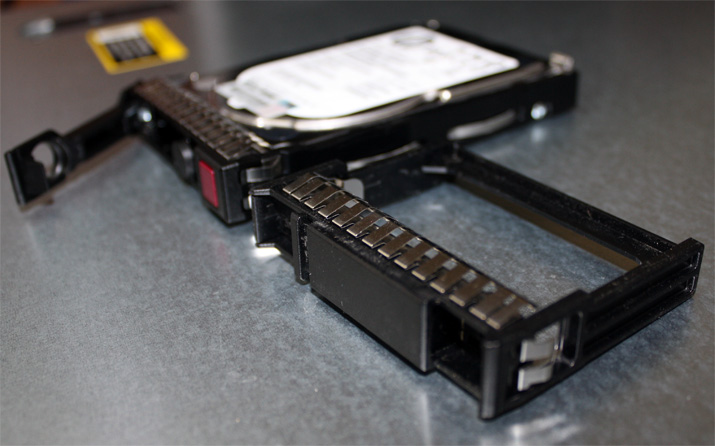
Now the LEDs are placed on the disk basket itself. Behind there was an additional group of contacts of the basket in addition to the standard power connector and SAS. Discs are different models. For example, the disks we purchased are HP SmartDrive carriers. As it was found out from the documentation, in these disks (or a basket?) There is an additional microcontroller that collects telemetry data from the disk, like a black box in an airplane, and also verifies the authenticity of the disk.

Finally finished with an external inspection and climb to look inside. The server opens just like other HP servers. For example, as DL360. If it is closed, the key-screwdriver can be found behind the server.

The first thing that caught my eye was the BBU SAS controller located in front of a group of frontal fans, immediately after the HDD and DVD drive compartments.

Here he is. The decision is extremely correct. On some models of Intel BBU servers, the controller is located in the hottest weather-proof area, which contributes to the overheating of the BBU and its failure.
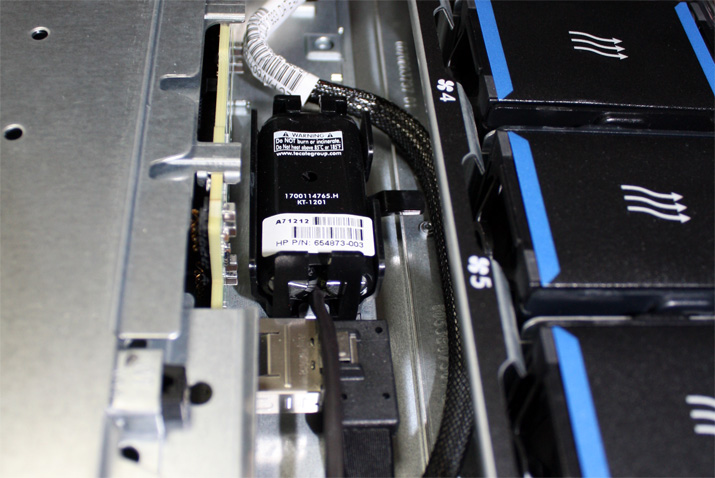
Fans are not fixed, but simply sit in their cells. Removed without tools and effort.

Among the general accuracy, several carelessly and somehow randomly arranged fan power cables are knocked out.

Here it is, beauty! 24 slots for DDR-III memory modules and 2 slots for CPU. On a transparent duct marked numbering of memory slots. Of course, on the inside of the server, there is also a memory module layout on the inside, but, you see, it is much more convenient and clearer.
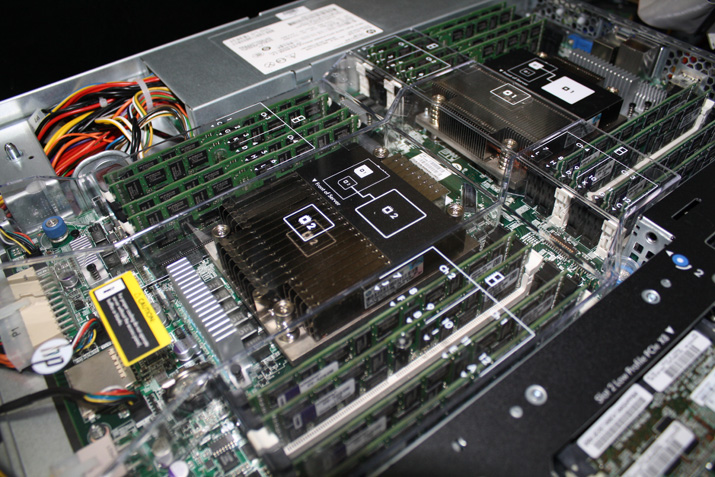
As you can see in the previous photos, the CPUs are located one after another. This is clearly not conducive to cooling processors. But HP engineers changed the radiators. Now, the radiator of the “front” CPU has a smaller surface area, while the “rear” processor has a radiator fence more often and, accordingly, the surface area is larger.
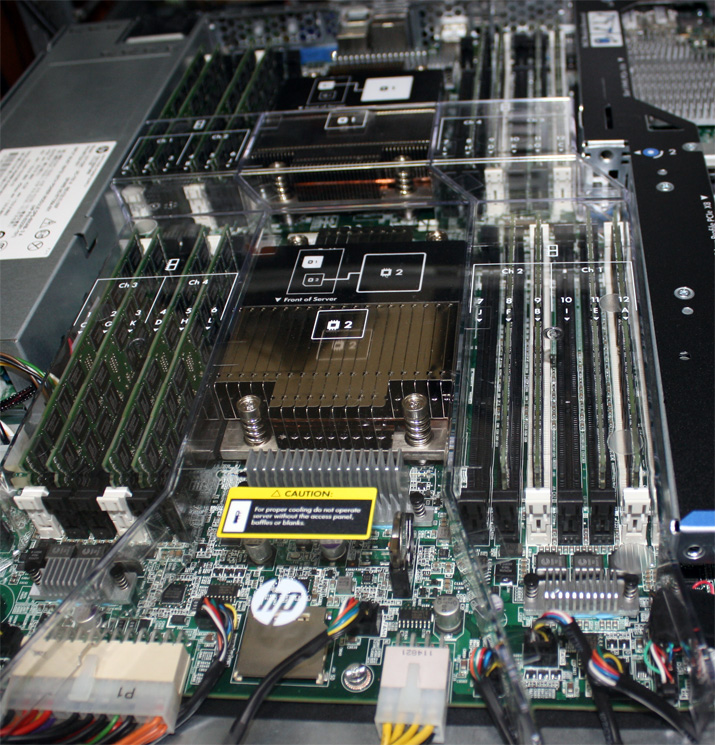
The internal low-profile PCIe X8 slot is already occupied by the HP P420 controller, but if necessary it can be replaced with something else.
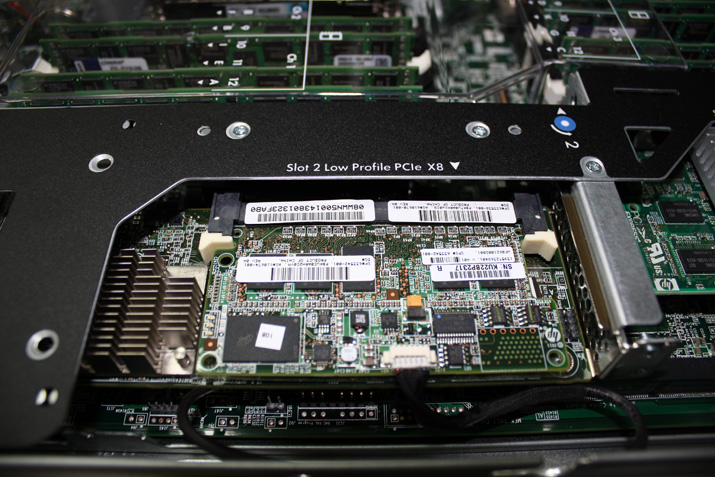
Full size PCIe X16 slot is empty. We installed a 2 x 10Gbit / sec SFP + network card into it. Although this slot could not be occupied: under the network card you can see the place for the installation of a special card with network ports. You can put as a few more ports 1Gbit / s, and 10Gbit / s.

We will be glad if this information turned out to be interesting to someone and we will be even more happy if it turns out to be useful.
The other day there was a task to give the client a server with a large amount of RAM, but with a small number of disks. According to the client’s technical specification, the server must provide output to the Internet at a speed of 10-15 Gbit / s.
Usually we bought HP DL180 G6 servers of 2U size and 25 bytes for HDD / SSD for such tasks. But here the task was somewhat different, and we decided to try the new HP ProLiant DL160 8th generation.
')
Some useful details about the HP DL160 G8
- 24 slots for DDR-III memory;
- support up to 384Gb RAM;
- 8 x 2.5 ”HDD / SSD;
- The new controller P420 (with 1Gb of memory and BBU);
- the ability to install an additional NIC module (for example, with 10 Gbit / s ports) without occupying a PCIe slot;
- Full size PCIe X16 slot.
Detailed information on this model can be found on the manufacturer's website, and I just want to share photos of fresh iron that can please connoisseurs.
Open the box, look ... what did you bring? Here is such a DL160 G8! The differences from the DL160 G5 are big. The DL160 line is increasingly stretching into the more expensive DL380 line. For example, there is already a place under the protective panel that restricts access to the HDD.

If you order a complete set without disks, then get ready that the server will arrive without one stub. Fans of diskless servers (for example, for a VMware cluster) will have to buy another server to parse the stubs. On the front side of the server there is also a monitor output, 2 USB ports, a power button and a LED button for many of your favorite UIDs.

Special attention should be paid to the disks. Much has changed. Even the stubs of the empty compartments have changed.

Now the LEDs are placed on the disk basket itself. Behind there was an additional group of contacts of the basket in addition to the standard power connector and SAS. Discs are different models. For example, the disks we purchased are HP SmartDrive carriers. As it was found out from the documentation, in these disks (or a basket?) There is an additional microcontroller that collects telemetry data from the disk, like a black box in an airplane, and also verifies the authenticity of the disk.

Finally finished with an external inspection and climb to look inside. The server opens just like other HP servers. For example, as DL360. If it is closed, the key-screwdriver can be found behind the server.

The first thing that caught my eye was the BBU SAS controller located in front of a group of frontal fans, immediately after the HDD and DVD drive compartments.

Here he is. The decision is extremely correct. On some models of Intel BBU servers, the controller is located in the hottest weather-proof area, which contributes to the overheating of the BBU and its failure.

Fans are not fixed, but simply sit in their cells. Removed without tools and effort.

Among the general accuracy, several carelessly and somehow randomly arranged fan power cables are knocked out.

Here it is, beauty! 24 slots for DDR-III memory modules and 2 slots for CPU. On a transparent duct marked numbering of memory slots. Of course, on the inside of the server, there is also a memory module layout on the inside, but, you see, it is much more convenient and clearer.

As you can see in the previous photos, the CPUs are located one after another. This is clearly not conducive to cooling processors. But HP engineers changed the radiators. Now, the radiator of the “front” CPU has a smaller surface area, while the “rear” processor has a radiator fence more often and, accordingly, the surface area is larger.

The internal low-profile PCIe X8 slot is already occupied by the HP P420 controller, but if necessary it can be replaced with something else.

Full size PCIe X16 slot is empty. We installed a 2 x 10Gbit / sec SFP + network card into it. Although this slot could not be occupied: under the network card you can see the place for the installation of a special card with network ports. You can put as a few more ports 1Gbit / s, and 10Gbit / s.

We will be glad if this information turned out to be interesting to someone and we will be even more happy if it turns out to be useful.
Source: https://habr.com/ru/post/147676/
All Articles